1959 Monaco Grand Prix race report: Brabham takes his and Cooper's debut win
Stirling Moss's mechanical failure is Jack Brabham's good fortune as he and Cooper win for the first time
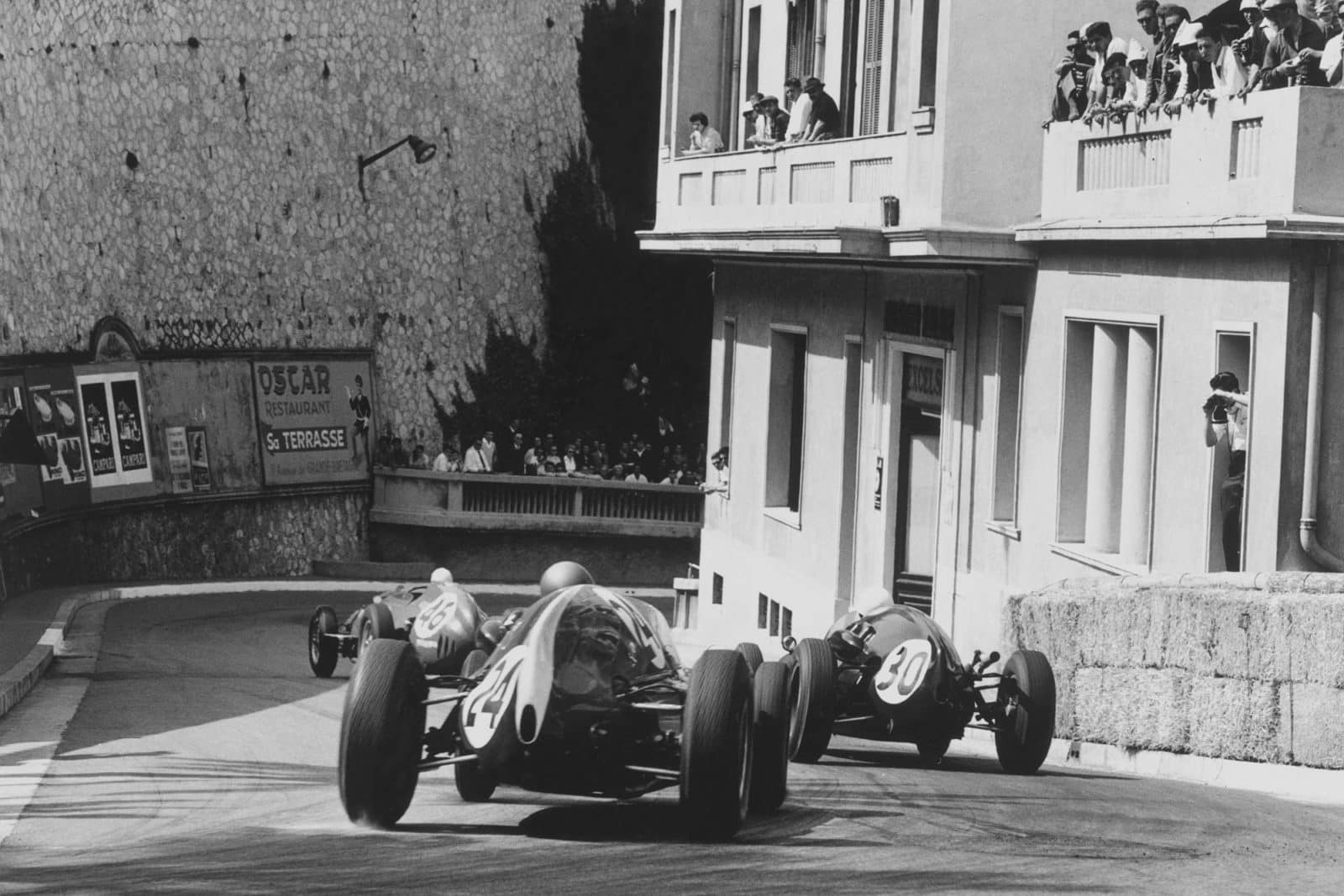
Jean Behra in a Ferrari Dino 246 leads Stirling Moss in his Cooper T51-Climax
© LAT Photographic
With the Argentine races being cancelled the Monaco GP became the first round in the World Championship series and the first occasion when all the Grand Prix teams brought out a full complement of their latest cars. A break from tradition was the dropping of early morning practice, all three practice periods being in the afternoon, and another change was the addition of a Junior Formula race on the Saturday afternoon.
First practice was on Thursday afternoon under a cloudy sky that made Monaco look drab but was nevertheless excellent for high speed motoring, with no heat to melt tar, no glare from the white buildings and less of a sharp “blackout” as the cars rushed through the tunnel on the sea front. With the circuit unchanged from last year the lap times set then were good targets and in addition there was the incentive to try really hard for only the fastest 16 during the three practice period would qualify for the starting grid.
The official lap record for the 3.14 kilometre circuit stood at 1min 40.6sec set up during the 1958 race, but in practice that year Brooks had taken a Vanwall round in 1min 39.8sec, so it was reasonable to look upon a time in the 1min 40sec as something worthwhile. Most people were out for practice, but noticeable absentees were the Cooper-BRM, Moss preferring to try a Cooper-Climax to start with, the two works Lotus cars, their transporter having broken down on the way from England, and the two Porsches of de Filippis and von Trips.
Qualifying
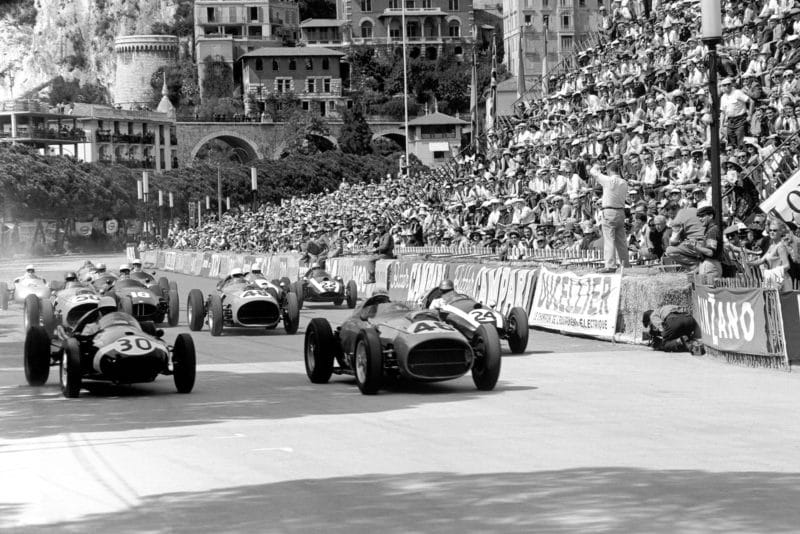
The race starts, with Stirling Moss, number 30 Cooper T51-Climax, and Jean Behra, number 46 Ferrari Dino 246, Tony Brooks in number 50 Ferrari Dino 246, Jo Bonnier, number 18 BRM P25, Phil Hill in number 48 Ferrari Dino 246, and Jack Brabham, number 24 Cooper T51-Climax.
© LAT Photographic
For the first half-hour everyone went round pretty quietly, feeling their way and getting accustomed to the circuit, with its multitude of stone walls and kerbs, to say nothing of trees and lamp-posts. Schell was one of the first to start trying, with a lap in 1min 47sec with the BRM but then things started warming up and Coopers and Ferraris began to go quickly, Moss and Behra looking fast, and Schell found he was quite unable to keep up with the Walker Cooper-Climax.
Salvadori was going well in the Atkins Cooper-Maserati, the engine sounding beautiful under fierce acceleration, while Brabham looked to be enjoying himself round the corners as was Allison with the F2 Ferrari which he had been given with the object of an opportunity to learn to drive a Ferrari, this being his first race with a single-seater from Maranello. Halford was in trouble still with the gear selector mechanism on Fisher’s Lotus and Phil Hill was looking a little wild and seemingly trying too hard. Brooks was looking the complete opposite and it called for a stopwatch to convince one that he was at all fast. Behra was driving in a determined manner but tidily nevertheless and all the Ferrari drivers were looking lost, hidden away in the cockpit, the offset engine and prop-shaft permitting a remarkably low seating position.
“Braking really hard on the curve down to the Gasworks hairpin, the car was sideways-on for some yards and it was only the mastery of Moss that got away with it”
By 3pm everyone was well and truly wound up and Moss was going round in just under 1min 42sec, his best being 1min 41.7sec, but he had not long done this before Behra put one in at 1min 41.6sec. Brooks was overtaking Halford, going into the tunnel when he got on some loose gravel and spun wildly through the darkness, but continued reasonably unabashed. Not long after Behra made the fastest time Moss was out again and the Cooper-Climax looked horribly unstable as it came out of the Tobacconists corner and was still snaking and wiggling by the time it reached the pits. Braking really hard on the curve down to the Gasworks hairpin, the car was sideways-on for some yards and it was only the mastery of Moss that got away with it.
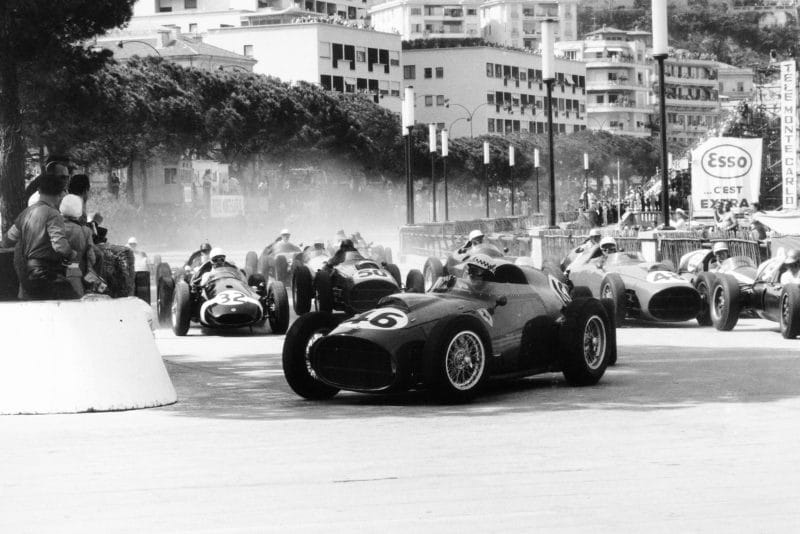
Jean Behra driving a Ferrari Dino 246, leads Stirling Moss in his Cooper T51-Climax and Jack Brabham driving Cooper T51-Climax at the start of the race.
© LAT Photographic
Up at the top of the town, crossing the Casino square it was just as exciting to look at and the result was first of all a fastest time of 1min 41.3sec and then 1min 41.1sec. While this Behra vs Moss contest was being watched closely, for Behra went out again immediately after Moss had stopped, Brooks was going round unobtrusively and had clocked 1min 41.4sec. Behra continued until 3:30pm when practice finished but he could not improve on his earlier time and though the lap times were not approaching last year’s best they were quick enough for the first day, the final order being Moss, Brooks and Behra.
On Friday practice was a little later in the afternoon and again it was dry and cool and though the two Porsches now appeared, the factory car causing a lot of eye-brows to be raised, there was still no sign of the Lotus team. Both Ferrari and BRM had their spare cars out and the Walker Equipe had the Cooper-BRM at the pits as well as their two Cooper-Climax cars. Behra was off as soon as practice began and Moss was not far behind, but only for one lap as he found he could not select gears correctly, so he stopped and went off in the Cooper-Climax.
Von Trips was getting accustomed to the tiny Porsche as was de Filippis, but she was having difficulty in selecting first gear on the standard RSK gearbox. Behra was soon in his stride and clocked 1min 41.4sec while Phil Hill was alternating between his own car and the practice car, for being his first race at Monte Carlo he had a lot to learn.
With very little warning, except perhaps for a look of concentration, Brabham slipped in a remarkable lap in 1min 40.9sec which really stirred things up. Both Behra and Moss were soon out again and trying hard, the Ferrari driver scoring 1min 40.7sec and then 1min 40.4sec. He stopped at that, having been using 9,000rpm and was looking a bit hot, and Moss also stopped, having not improved on the best time. The Cooper-BRM was restarted and he did another lap but the gear selection was still not right so the car was abandoned.
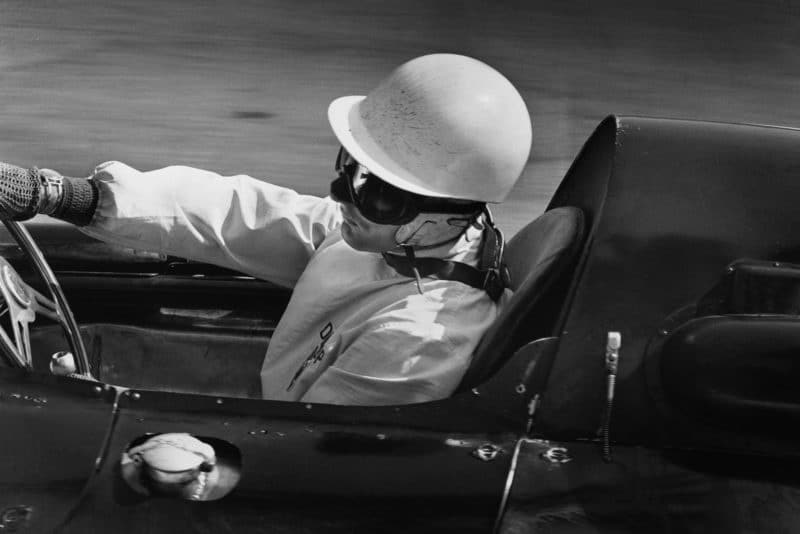
Stirling Moss at the wheel of his Cooper T51-Climax.
© LAT Photographic
Gearboxes are a big problem on most circuits and especially at Monte Carlo, where so many gear changes are made and the possibility of mistakes is enormous. Allison came in with the Ferrari F2 showing well over 10,000rpm on the tachometer having inadvertently changed down from fifth to second, but luckily with no resultant damage. Von Trips was not too happy sorting out the six-speeds on the works Porsche as there was no visible gate on the gear-change and he was frequently heard to change from second to fifth. The car was going remarkably well on its first appearance and was easily as fast as the F2 Ferrari and sounding perfect as regards carburation.
“At 6pm, with only 30 minutes left, there was a sudden rush of activity and the tempo became absurdly hot”
Brooks had a go in the Ferrari practice car and later Allison tried it, but it was not as fast as the F2 car, being a rather tired hack machine; however, all three drivers, Hill, Brooks and Allison, recorded virtually the same lap times with the car. The BRM team seemed happy enough but were not making any startling times, Schell and Bonnier being almost identical, with Flockhart only a little slower. As de Filippis was not going fast enough to qualify in the Porsche, her best time being 1min 49sec, Behra let Edgar Barth try the car, but being new to the Monaco circuit he could not go as fast as the Italian.
At 6pm, with only 30 minutes left, there was a sudden rush of activity and the tempo became absurdly hot, with Moss, Hill, McLaren, Gregory, Salvadori, von Trips, Flockhart, and Brooks all trying pretty hard and then Brabham joined in going very fast and looking most comfortable. Phil Hill was beginning to feel his feet and got down to 1min 41.3sec, and Brooks did 1min 41.9sec, while Brabham upset things once again with 1min 40.1sec. As practice finished Moss did two really quick laps in a last-minute try to beat the Australian but his best was 1min 40.3sec.
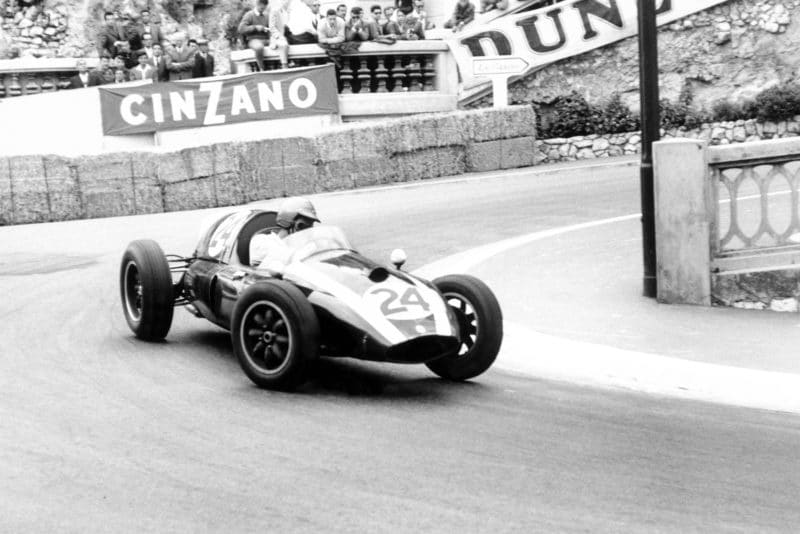
Jack Brabham driving his Cooper T51-Climax.
© LAT Photographic
For the third and final practice, conditions were once more unchanged and at last the Team Lotus cars had arrived. This was the last opportunity for the tailenders of the field of 24 cars to decide who was going to qualify and who wasn’t and it seemed certain that the last few places left after the works teams were accounted for would go to the faster F2 cars.
Moss was still on the Cooper-Climax, the BRM special not even appearing this day; and as soon as practice began almost everyone went out, though Graham Hill was delayed at the pits for a time, the Lotus not being quite ready. He had not gone long before Lovely appeared in sight from the Tobacconists Corner wheeling his Lotus backwards, having spun and stalled.
Everyone was trying pretty hard now, the faster boys trying for the all-important front row of the grid and the slower ones endeavouring to get under 1min 45sec, for although there was no fixed lap time for the 16th qualifier, it was becoming increasingly apparent that this time would be about the slowest on the starting grid, and as the front row were around the 1min 40sec mark it meant that even the back row of the grid were going to have to drive very fast.
Moss and Trintignant were both driving hard and Allison was doing a great deal of lapping in the F2 Ferrari, but was not as quick as von Trips in the works Porsche. With so many hairpins to negotiate rapid pick-up on carburation is an essential at Monaco, and also a rapid gear-change, and watching the cars out of the Gasworks hairpin was most interesting. The Ferraris could put the power on hard very early and leave the corner with the tail just a shade out of line, though when trying hard Behra was going a long way up the road on left lock, leaving the Climax cars visibly.
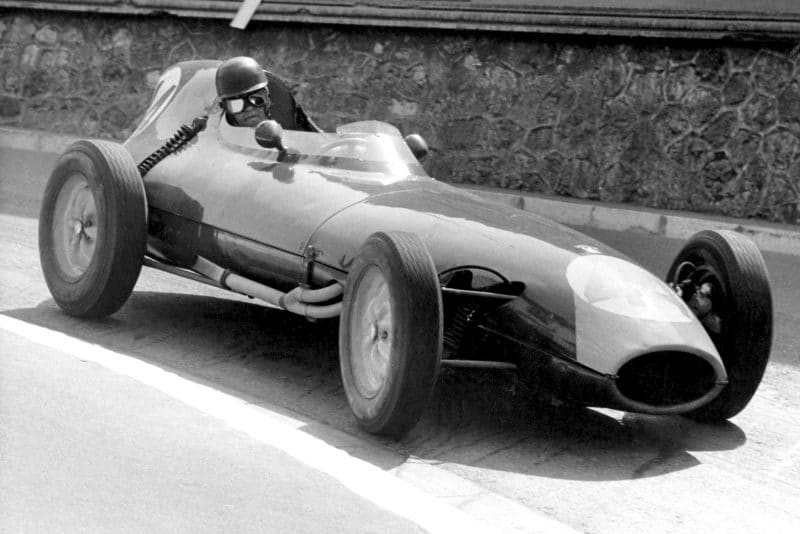
Bruce Halford in his Lotus 16-Climax.
© LAT Photographic
The Walker Coopers were not perfect, there being a slight hesitancy on pick-up, but the works Coopers were very good. Having had no time for doing carburation the poor Lotus drivers were suffering and went away in a series of splutters and bangs until well up the rev-range, but even so Graham Hill was down to 1min 43.9sec, but this paled into insignificance in comparison with von Trips in the Porsche who had done 1min 43.8sec with only 1,500cc. The pick-up of the flat-four air-cooled car was quite fantastic and many times it would leave an F1 car in the initial acceleration away from the hairpin, and providing the driver didn’t miss a gear change it sounded like a four-cylinder Gilera or MV motor-cycle with its high revs and fantastically fast gear change.
Phil Hill did only a few laps in his own car and then went on learning in the practice car and later on Brooks had another go in it. It was becoming increasingly obvious that Brabham was a real menace, for although he didn’t go out as often as some, when he did he made very quick times, seemingly without having to wait for a clear track. Moss now had a clear run in front of him and taking every opportunity he fixed everyone with a lap in 1min 39.6sec. This stirred Behra who replied with 1min 40sec and just to remind the big boys that they were not alone Brabham did 1min 40.7sec. The BRM team were right out of the picture, even though it was only a matter of 3sec and Schell was doing his utmost, but nevertheless they had no qualms about being in the fastest 16. The F2 drivers were scrapping like mad in order to be “tail-end Charlie” and Halford and Bueb were going very fast for ordinary private-owner cars, in fact faster than the works F2 Ferrari, though the Italians hadn’t noticed this being pre-occupied with the bigger cars.
“There was some furious driving, cars sliding, wheels locking, tyres screaming, drivers perspiring and engines being made to give all they had got”
Once more 6pm seemed to be the signal for a last dice and there was some furious driving, cars sliding, wheels locking, tyres screaming, drivers perspiring and engines being made to give all they had got. This was a brief and exciting period of real racing driving, and in the middle of it all Brabham lost the Cooper as he braked past the pits and arrived at the Gasworks hairpin going backwards and still spinning, ending up with a very light bump against the straw bales; he still had the engine running and was quickly off again, lapping just as fast.
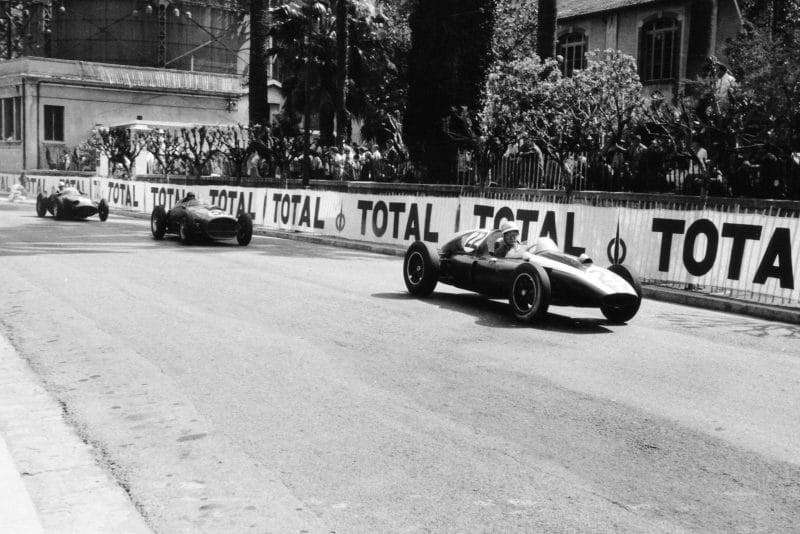
Bruce McLaren in a Cooper T51-Climax leads Tony Brooks in his Ferrari Dino 246 and Harry Schell driving a BRM P25
© LAT Photographic
Still holding the fastest time of practice with the Cooper-Climax, Moss went along to the Bourne team and tried the practice BRM but proved nothing, being only a fraction of a second faster than the team drivers. To go from the rear-engined Cooper to the front-engined BRM and expect to do equal times on such an exacting circuit as Monte Carlo was asking too much, even for Moss. Suddenly all the pandemonium of the last-minute dice was over, many people waiting to see if they were on the starting-grid or not, when the Scuderia Ferrari suddenly woke up and realised that Allison hadn’t qualified their F2 car. Just as the circuit was about to be closed he went out and in the last two laps of practice got in a 1min 44.4sec lap, which knocked the unfortunate Bueb off the end of the list, after he had tried so hard.
The 16 starters were headed by Moss with 1min 39.6sec and ended with Halford with 1min 44.8sec, which gives a good indication of how hard everyone had been driving. The two most unfortunate non-starters were Bueb, who had done 1min 44.9sec, and Scarlatti with 1min, 45.0sec, but the line had to be drawn at 16; the rest were considerably slower.
Race
Sunday saw real Monte Carlo weather, blazing sunshine, blue sky and all the colour and atmosphere that is traditional with this race. At 2.30 p.m. the 16 cars were wheeled out to the starting-grid and lined up as follows:
See table representing grid formation.
In the mad rush for the first corner there was surprisingly little bumping, Behra was leading and refused to let Moss squeeze by on the inside, and as they went up behind the pits to start the 100-lap race the order was Behra, Moss, Brabham. As can be imagined, on such a tight circuit the first lap saw the whole field virtually nose-to-tail, with the three F2 cars bringing up the rear, and as they rounded Ste Devote corner and headed up the hill to the Casino for the second time, someone slopped some oil from an over-filled tank and von Trips went sideways on it, right in front of Allison and Halford. At such close quarters no-one could do anything, and three very bent F2 cars finished up on the pavement and out of the race, the drivers luckily escaping with minor cuts and bruises.
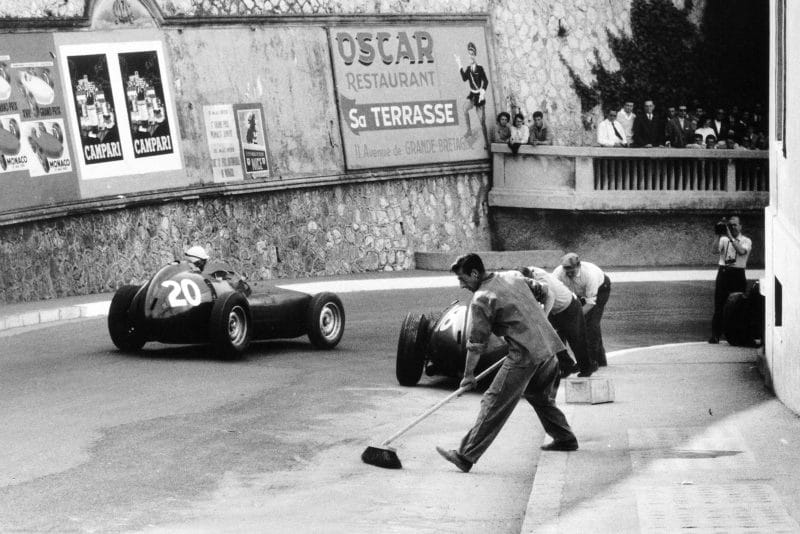
Ron Flockhart in BRM P25 number 20 passes Harry Schell in another BRM P25.
© LAT Photographic
After only four laps the pattern of the race took shape, Behra led Moss by seldom more than a length or two and Brabbam was following closely and at his ease. These three had already drawn away from Phil Hill, who was in fourth place, and he in turn had drawn away from Trintignant. Some way back came the remainder of the field, still bunched together and trying to sort themselves out, in the order Bonnier, McLaren, Brooks, Schell, Gregory, Salvadori, Graham Hill and Flockhart, and in the next four laps they did so. Gregory had his clutch pack up and then the gearbox and retired, and McLaren had a slight tangle with Schell at the chicane and found himself at the back of the field after stopping to see if the rear suspension was all right.
Meanwhile the three leading cars were going round as if tied together, Moss not trying to overtake but keeping the Cooper very large in Behra’s mirrors in the hope of worrying him, while Brabham was content to sit and watch. Phil Hill was trying too hard for comfort and Trintignant closed up on him, the twice-winner at Monaco driving very nicely and sitting in a firm fifth place. Brooks was sandwiched between the BRMs of Bonnier and Schell and obviously being held up, which was unfortunate, as he was rapidly losing touch with the leaders, with whom he should have been, but on lap 11 he got by Bonnier and soon out-distanced the cars from Bourne, but could not catch Trintignant.
On lap 18 Trintignant arrived at the hairpin too fast with his throttle stuck open, cut the ignition and scrabbled round on a dead engine, restarting and stopping at the pits at the end of the lap to have it fixed, which dropped him to next to last place and a lap behind the leader. After 20 laps the leading three cars looked exactly the same as they had done on lap one, and Phil Hill was now a very lonely fourth and Brooks fifth, but Schell had got past Bonnier and was worrying Brooks.
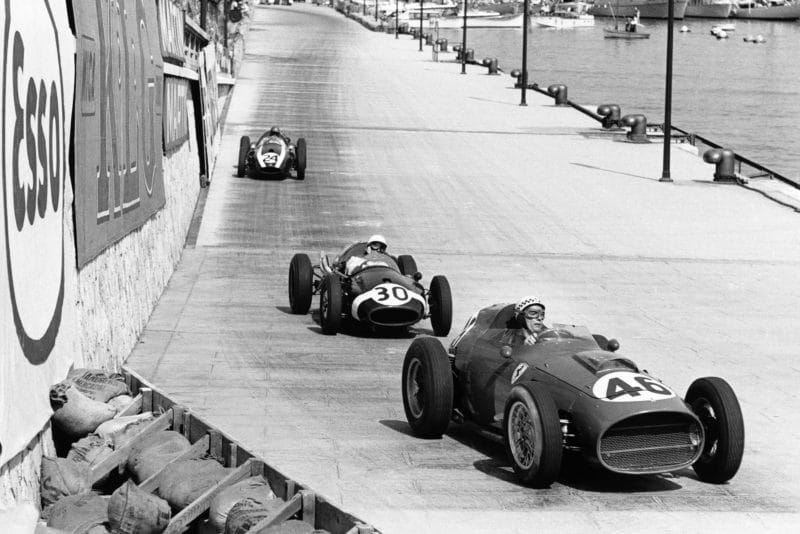
Jean Behra in his Ferrari Dino 246 leads Stirling Moss in a Cooper T51-Climax and Jack Brabham also in aCooper T51-Climax.
© LAT Photographic
It seemed as if the outcome of the Behra, Moss, Brabham scrap was going to be one of nerves, but on lap 22 the Ferrari slowed down and Moss went by, and the next lap Brabham went by and clearly the Ferrari was in trouble. As Behra started lap 25 he was in real trouble and the bottom fell out of the engine and he strewed oil all over the Gasworks hairpin, coming to rest behind the pits. This left Moss comfortably in the lead, with Brabham smiling quietly to himself a few lengths behind.
“Behra was in real trouble, the bottom fell out of the engine and he strewed oil all over the Gasworks hairpin, coming to rest behind the pits”
While this turn of events had been taking place, Graham Hill stopped hurriedly just past the Station hairpin with an uncomfortable oil fire burning under his elbow and leapt out to extinguish it with his own fire-fighting apparatus, and Brooks had been worn down by Schell and dropped a place. These two were running very close together and lapped Trintignant, but the little Frenchman was trying to make up time and when he found himself between the BRM and the Ferrari he stayed there.
Moss now had things all his own way for he knew Brabham was not going to worry him, and the Australian was intelligent enough to know that he was a safe second and it would be futile to ‘try anything on’. During the opening laps Behra and Moss had been lapping at around 1min 43 sec, but now that all was safe Moss slowed to 1min 45sec, but even so was pulling away from Brabham and by lap 30 had a 16sec lead, the Australian having a 26sec lead over Phil Hill, who was in turn 32sec ahead of Schell and Brooks, who were still in close company, Bonnier having dropped back as his rear shock-absorbers were not working properly. To complete the field came Salvadori, driving a steady and regular race, Flockhart, Trintignant and McLaren.
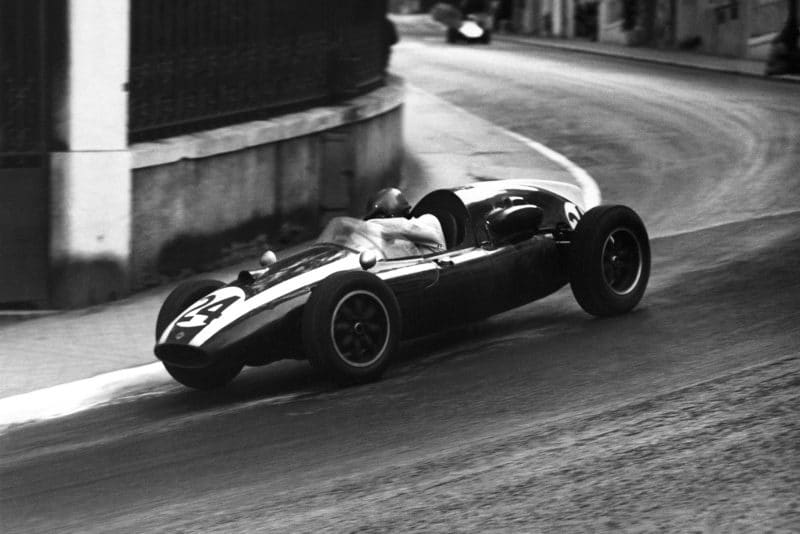
Jack Brabham pushes his Cooper T51-Climax into 1st place.
© LAT Photographic
Moss was now complete master of the situation, touring round at his ease and ticking the laps off like clockwork, lapping the tail of the field for the second time. On lap 36 Phil Hill, who was a firm third now, lapped Bonnier, and the next lap he spun at the Casino square and dented the Ferrari tail. He continued but now had Schell and Brooks right behind him, and on lap 38 they both passed him and left him behind, so at lap 40 the order was Moss (Cooper-Climax), Brabham (Cooper-Climax), Schell (BRM), Brooks (Ferrari) and Hill (Ferrari), the rest having been lapped, and the Maranello pit must have been feeling very sick.
On lap 44 Hill was again overdue, having spun once more at the Casino, and Bonnier was obviously in trouble as Salvadori and Flockhart had passed him. On lap 43 the Swede stopped at the pits, did one more lap and then retired with a lack of brakes. Barely had the BRM pit realised that the first of their cars was out when Schell was missing, having gone straight on into the straw bales at the Casino Square. He pulled the car out and restarted down the hill towards the Hotel Mirabeau, but did not get far as both oil and water radiators had been split in the crash.
At 50 laps, just half way, there were only eight cars left running, with Moss sitting pretty with a 40sec lead over Brabham, who was in turn 30sec ahead of Brooks, the rest being a lap or more behind. As Flockhart arrived at the Gasworks on lap 55 he was in trouble with his brakes locking on and had to use all the road to get round, which let Trintignant slip by, and Moss as well, for that matter, as the leader was lapping the tail-enders yet again.
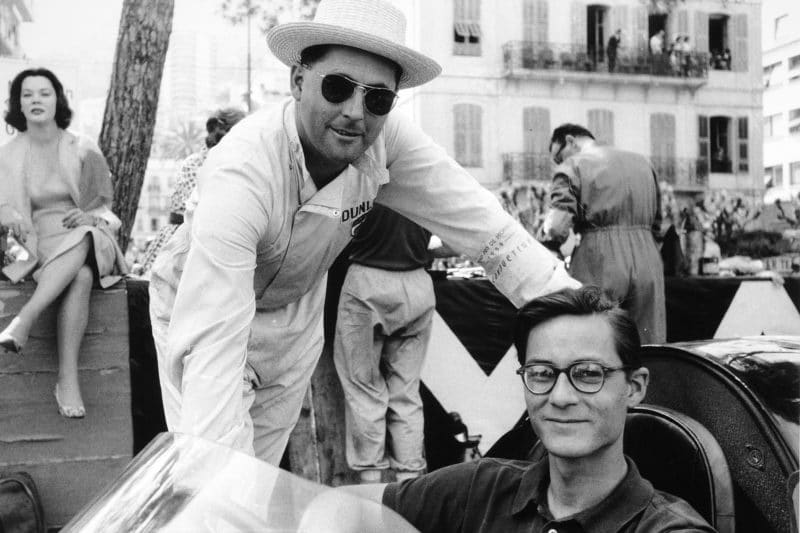
Cooper T51-Climax drivers
Jack Brabham and Masten Gregory
© LAT Photographic
It now seemed that nobody was going to catch anybody and the scene became a bit monotonous, though Brooks was closing a little on Brabham, but unless he made a big effort, and Brabham did not notice it, it was unlikely that the Ferrari would steal second place. Brabham lapped Phil Hill by lap 60, and on lap 65 poor Flockhart spun at the entrance to the Casino square, stalled the engine and, being unable to restart, had to abandon the race, and on lap 68 Hill spun for the third time at the same place and this time buckled both left-hand wheels, stopping at the pits to have them changed, this mistake dropping him to sixth place just a lap ahead of the last man, McLaren, whose Cooper was suffering from a bent chassis. Trintignant now caught up with Salvadori, whose regular driving had given him fourth place, and for a few laps these two scrapped together but the Frenchman got the advantage.
“This end-of-race attempt by Brooks to wrest second place from Brabham was suddenly shattered”
By lap 80 it was a matter of time before Moss won, but Brooks was making a big effort and had whittled the gap between himself and Brabham down to 11sec, but the Australian was quite happy and on lap 83 he not only improved on the fastest lap, held then by Moss in 1min 42.3sec, but set up a new lap record with a time of 1min 40.4sec.
This end-of-race attempt by Brooks to wrest second place from Brabham was suddenly shattered by Moss stopping at his pit. He sensed a vibration in the transmission and thinking it might be something repairable like loose bolts in a universal joint he came in. Nothing was visibly wrong and he rejoined the race still in the lead, but with a sinking heart for he knew something was wrong somewhere. He had hardly got to the Gasworks hairpin before there was an awful grinding noise from the rear end and his race was run and Brabham and Brooks went by.
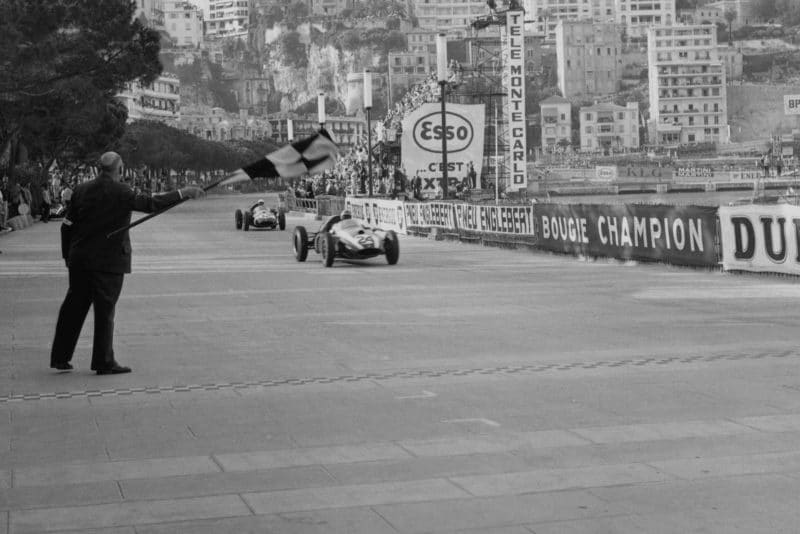
Jack Brabham takes the chequered flag for the win
© LAT Photographic
His feeling that something was coming loose was well founded for the bolts holding the crown-wheel to the differential cage were shearing off and the end came when the broken heads picked up in the teeth of the rear axle and in the integral gearbox. Two laps later Salvadori coasted into his pit with his crown-wheel and pinion stripped and, having completed 80 per cent. of the race, waited to wheel the car across the line and be classed as a finisher.
Brabham went on with beautiful regularity, though by now beginning to feel that the race was a very long one, and Brooks began to feel sick from exhaustion and the heat and smells in the very enclosed Ferrari cockpit, and made no further attempt to worry Brabham. Two laps behind came Trintignant, still driving with his calm precision, and one lap later came Hill, driving as though his very life depended on it, and having frequent moments at the Gasworks turn, while up at the Casino the crowds waited expectantly for him to spin yet again! At long last the 100 laps were completed by the first two cars and the others were flagged off and Salvadori wheeled the stricken Cooper-Maserati across the line. Brabham was an exceedingly popular winner and Brooks received a great ovation for trying hard, while poor Behra and Moss had to grin and bear it.
Monaco Musings
- Unhappy Ferrari, first Cooper keeps trouncing his F1 cars and now Porsche have done it again with a F2. But the Commendatore will not give up and he has four first-class drivers.
- Amazing how racing engines can be abused these days on low compression-ratios, both the F2 Ferrari and Porsche must have been over 10,000rpm when gear-changes were muffed, and Halford’s Climax went to 8,500rpm, yet no valves touched pistons.
- Nice to still retain a classic race in as classic a condition as when it started; it is still 100 laps round the houses.
- A good race, many incidents but no-one hurt, and only six out of sixteen finished, indeed a test of mechanical and physical endurance, which is what motor racing really is.
Notes on the Cars at Monte Carlo
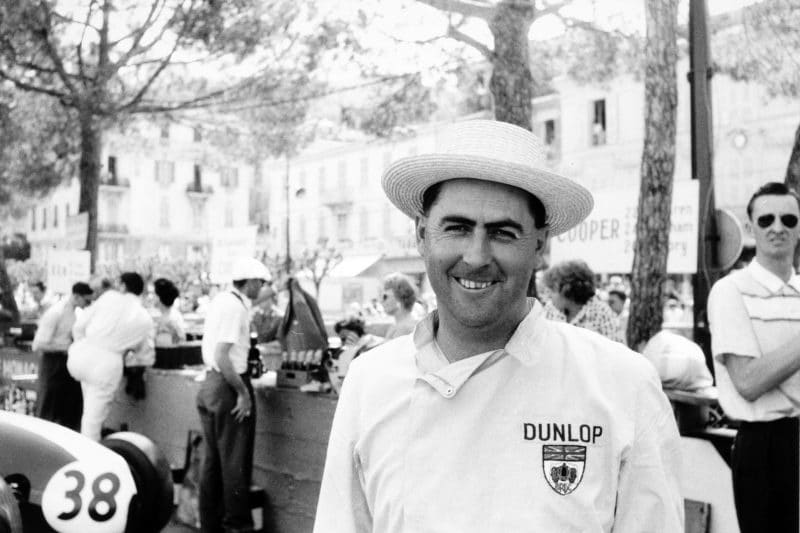
Jack Brabham who won in his Cooper T51-Climax
© LAT Photographic
Although the starting-grid was limited to the fastest 16 cars a total of 24 appeared for practice. The works Cooper team consisted of three cars, all with double-wishbone and leaf-spring rear suspension and disc brakes. Two of the cars, driven by Brabham and Gregory, had the new 2½-litre Coventry-Climax engine and the third car, driven by McLaren, had a 2.2-litre Climax engine. Of the big engines Brabham had 58-mm. Weber carburetters and Gregory had 48mm Webers, the American driver preferring the lower-rpm torque characteristics of this engine with the smaller-choke carburetters.
The Walker-Equipe were very busy with three cars, all basically Cooper but all of them much modified, these being the Cooper-BRM, an old Cooper-Climax and a new Cooper-Climax, both with 2½-litre engines. The Cooper-BRM was reputedly designed specifically with Monaco in mind, having a four-cylinder BRM engine in the rear of a modified Cooper chassis and driving through a Colotti five-speed gearbox, the BRM being as delivered by Bourne, with the exception of the magnetos being driven by internally-toothed rubber belts, an American-inspired principle of drive aimed at replacing chains. Just in case the Cooper-BRM proved unsuccessful there was last year’s Monaco-winning Cooper fitted with a 2½-litre Climax engine and a Colotti gearbox, and Moss had the choice of these two. The third Walker car was the much-modified Cooper-Climax for Trintignant, this car having a similar engine and gearbox to the older car but being a new chassis at the end of last season, and used by Moss in Australia and New Zealand, since which time it had been converted to Rudge k.o. hubs and Borrani wire wheels.
BRM had a full team of cars and a training car, the three entries being driven by Schell, Bonnier and Flockhart, and, apart from minor details, such as modified rear radius-rods on one car, they were all identical, having the long bonnet top air intake to the sealed box surrounding the two double-choke Weber carburetters.
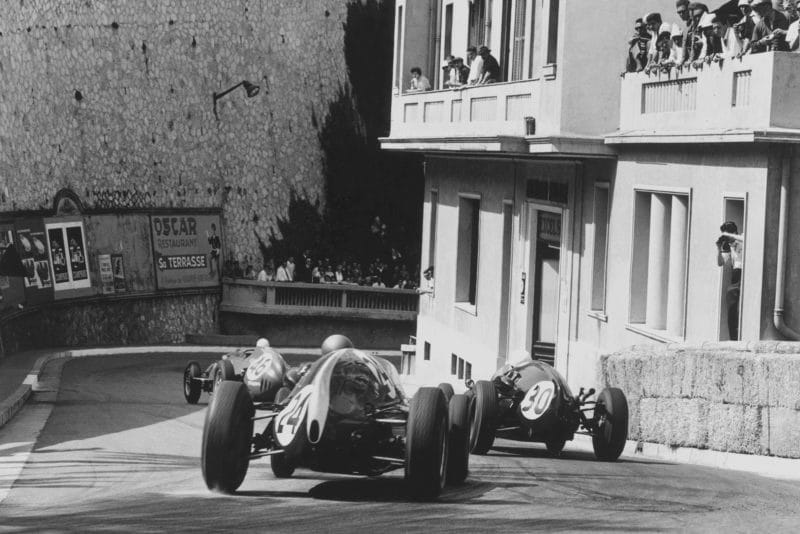
Jean Behra in a Ferrari Dino 246 leads Stirling Moss in his Cooper T51-Climax
© LAT Photographic
The Lotus team had two entries, both being the long slender 1959 cars with i.r.s. by a lower wishbone member, the drive shaft and the coil-spring unit and i.f.s. by wishbones and coil-springs with the anti-roll bar to the rear and kinked around the front of the engine. Graham Hill was entered in the car he drove at Siracusa recently, but with the 1,500cc engine changed for a 2½-litre unit, and the American driver Pete Lovely had the second of these cars. Both engines were fitted with 58mm Weber carburetters and had had the top chassis rail cut and kinked to give more clearance as it was found that the flexible engine mounting was allowing the carburetters to vibrate against the chassis.
Opposing this galaxy of British Formula 1 cars was a strong team from the Scuderia Ferrari, consisting of Behra, Phil Hill and Brooks in the latest coil-sprung, disc-braked Dino 246 models with V6 engines and the high wrap-round cockpit. In preparation for some close racing the long protruding nose cowlings had been replaced by short stumpy ones, and as a safeguard against overheating in the hot Monogasque sun the radiators had been enlarged, so that the cars had a strange appearance of having wide-open mouths. In addition to the three team cars there was a fourth car, with normal frontal treatment, being used as a practice car. To complete the Formula 1 entry there were two old 250F Maseratis, driven by Scarlatti and Testut and the Atkins Cooper-Maserati driven by Salvadori, its four-cylinder 2½-litre engine having recently been attended to at Modena and the front of the car having an enlarged air intake for the radiator.
The regulations allowed for a number of Formula 2 cars to enter and there were eight in all, and they had to compete on equal terms with the Formula 1 cars for a place in the 16 fastest qualifiers during the three practice periods. The Scuderia Ferrari brought along their Formula 2 car that Behra had driven at Siracusa, this time to be driven by Allison, and there were four private Coopers, all with Climax engines, two brand new cars belonging to the Equipe National Belge, driven by Bianchi and de Changy, an earlier one driven by the Frenchman Lucienbonnet, and the fourth being that of the United Racing Stable and driven by Ivor Bueb, this last team having taken over the entry at the last moment from the British Racing Partnership. There was a single Formula 2 Lotus, driven by Halford, and to complete the field, but without doubt of great interest, were two single-seater Porsches. The first was entered by Jean Behra and driven by Maria de Filippis, and had been built in Modena from a new sports RSK Porsche. Taking the original car, Behra had had a new tubular chassis frame built around the front and rear suspensions, following the general principles of the RSK but making it much narrower, though track and wheelbase were kept the same. A central driving position was built and the four-camshaft Spyder engine and gearbox were mounted in the normal position and the battery ignition, dynamo and starter were all retained. A close-fitted aluminium bodyshell was wrapped round these components, the resulting car being remarkably small and low in overall height and looking something like the lamented Sacha-Gordini of a few years ago.
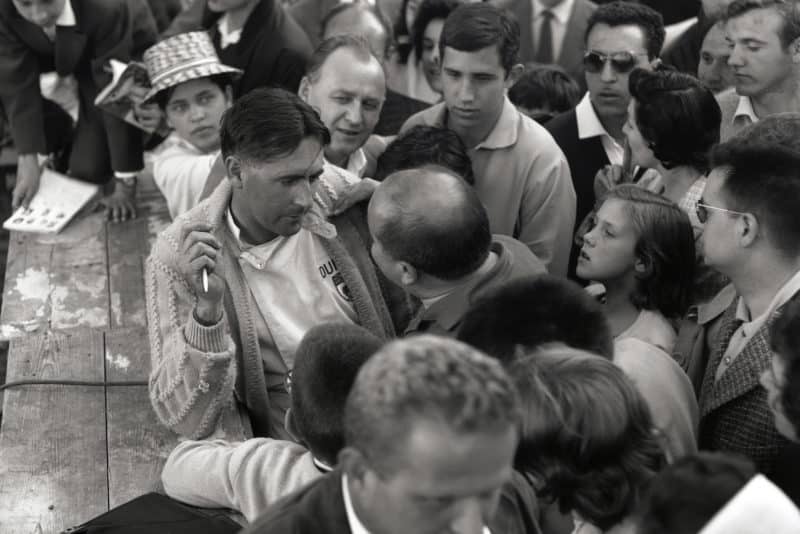
Jack Brabham talks with with a young autograph hunter.
© LAT Photographic
The other single-seater Porsche caused quite a stir, for, unheralded, it came from the Stuttgart racing department, with the works team and von Trips as driver. In general conception it was a single-seater RSK but being a factory design it was all new rather than being modified from standard. Front suspension was still by two trailing-arms on each side and transverse torsion-bars, with long thin telescopic shock-absorbers, but the rear suspension was new, though similar to experiments tried on sports cars earlier this year. Instead of the low-pivot swing-axle and Watt-link location used last season, with coil-springs the wheel movements were controlled by a system of triangulated links and radius-rods that gave the general effects of double-wishbones. Due to some intense work on geometry and the positioning of the triangulations, the static negative-camber of the rear wheels was maintained during the earlier part of the travel of the rear suspension, gradually increasing at the limit of the travel. In addition the roll-centre of the suspension stayed virtually at ground level until the last few degrees of travel were reached. Into this new chassis was fitted a normal works Spyder engine, even having a Spyder exhaust system complete with expansion boxes, but the transmission was something new, comprising a six-speed gearbox, all fitted into the normal RSK-type of tubular gearbox housing. In this new gearbox first gear was purely for starting from rest, after which the driver had a five-speed all-synchromesh box to use to keep the engine turning over around 8,500-9,000rpm, mixture being supplied by two enlarged double-choke Weber carburetters. Fuel was carried in a large tank on the left of the driver, another smaller one on the right, and a saddle tank in front of the scuttle, while oil was carried in a tank in the extreme nose with an oil-cooler mounted beneath, fed with cold air from a tiny slot in the nose cowling, the alloy bodywork on this car being rather ungainly but making it look even lower and smaller than the Behra car.
